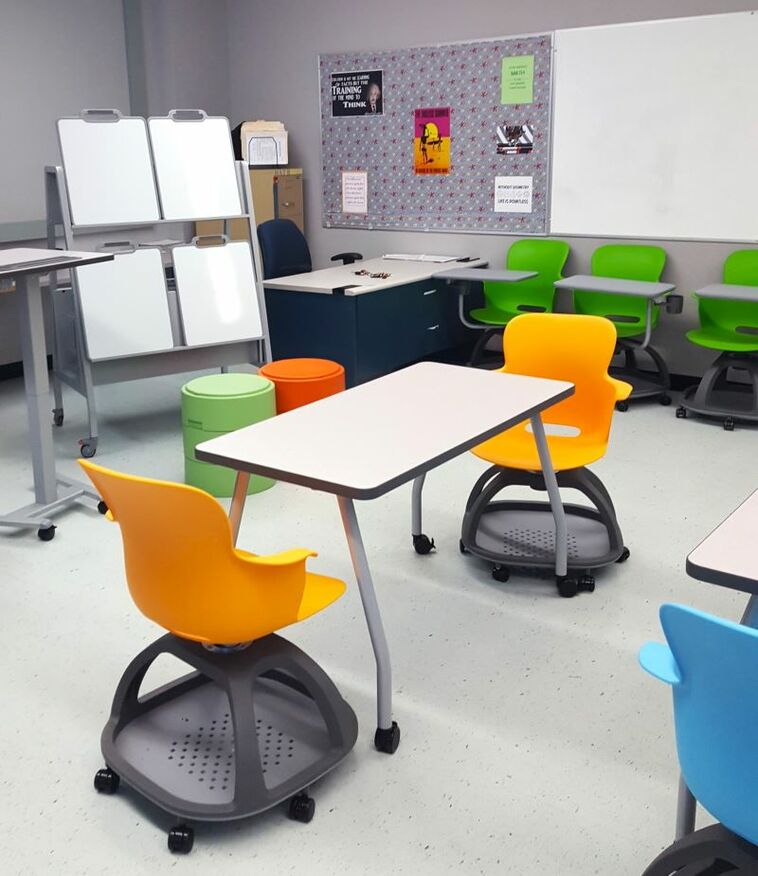In this era of recapturing the attention of students, engaging spaces are another tool to help learners’ minds connect with the material and one another to boost excitement over learning and results.
Encouraging the use of an active learning classroom is a focus of John Kerrigan, Director of Curriculum & Instruction at Middletown Township Public Schools in New Jersey and recent recipient of a Tech & Learning Innovative Leader Award for Innovative Curriculum Director. Kerrigan has an active learning classroom in his district and believes the concept can be an inspiration to others.
What is an Active Learning classroom?
The active learning classroom model that Kerrigan uses is a concept developed by Rutgers University. It features an alternative classroom arrangement with wall-to-wall whiteboards, collaborative seating, and the teacher’s desk in the middle of the room. Students can also use personal whiteboards and laptops in the room to research and collaborate.
“This type of classroom promotes a ‘guide on the side’ approach to teaching and learning, making the instructor one with the students rather than the sole dispenser of information in front of the room,” says Kerrigan. “I have been using these spaces with a flipped classroom model to really leverage deep mathematical discourse and learning in person that I can support. We took this room layout and brought it to our secondary math spaces, employing a variety of seat types, movable desks and tables, personal and wall-to-wall whiteboards, etc.”
While it may seem that a classroom “reno” project would only be possible in the land of deep pocket districts or schools able to take a hit to the budget, the design philosophy is based on proven results and studies that have shown the benefits of this type of collaborative learning. It can also be accomplished through innovative budgeting, grants, and professional development, or even appealing directly to companies who specialize in educational supplies.
“Our district supported this initiative to help increase students’ achievement in mathematics,” says Kerrigan. “We have also applied for grants through various local resources and classroom furniture/school supply companies to offset costs.”
It adds up to more than just a pretty place
These impressive spaces, combined with the technology-enhanced flipped classroom model, have led to significant gains in both scores and engagement.
“We have purposefully arranged for these spaces to be used by all grades 6-12 mathematics courses, including inclusion and Advanced Placement courses,” says Kerrigan. “We have seen consistent increases in the percentage of students earning a three or higher on AP Calculus AB, AP Calculus BC, and AP Statistics exams. We have also seen a positive trend in the New Jersey Student Learning Assessment (NJSLA) scores over the past two years since we have resumed testing.”
Reimagining the classroom also allows for additional attention to be paid to equity concerns and ensuring accessibility for students.
“We continue to decrease the opportunity gap by allowing all learners to use this space to participate in personalized learning activities,” Kerrigan says. “These spaces have also led teachers to buy into the ‘Building Thinking Classrooms’ model, which is currently popular in mathematics education.”
Welcome visitors, welcome results
History buffs might have heard stories of early America and the pineapple. Across the pond, the fragile nature and long delivery route made it such a status symbol that English gentry would rent the fruit as a table centerpiece to impress guests. George Washington became quite a fan while visiting Barbados. Being much closer to the growing region, presenting the fruit in colonial America was used as a sign of hospitality, displaying it outside the front door as a symbol that the host had returned from a journey and would again be welcoming guests.
This bit of historical trivia and tradition has lent itself to a new school symbol in Kerrigan’s district that also supports active learning.
“We are big advocates of teacher leadership and learning from classroom experts,” says Kerrigan. “The ‘Pineapple Chart’ method involves teachers willing to have visitors in their room place a pineapple outside their door. It is a symbol of hospitality. Then, each participating teacher shares a time range for an interesting part of their class (bell ringer, activity, technology implementation, active learning, etc.). Teachers can sign up to attend and watch for a short amount of time (pending coverage). This allows teachers to learn from their peers in the moment in the authentic live classroom environment.”
The district also offers job-embedded PD and open EdCamp-style PD sessions during which teachers propose topics and those interested participate in discussions. Encouraging connection and next-level educational enhancement continues in and out of the active learning classroom.
“We have seen more interest in STEM and taking risks in these spaces’ classrooms,” says Kerrigan. “In my conversations with teachers and students, they have said these spaces make them feel comfortable and more connected to their teachers.”
There’s a better way to display. Learn more at Epson.com/Education
This article was written by Sascha Zuger from Tech and Learning and was legally licensed through the DiveMarketplace by Industry Dive. Please direct all licensing questions to legal@industrydive.com.
![]()




